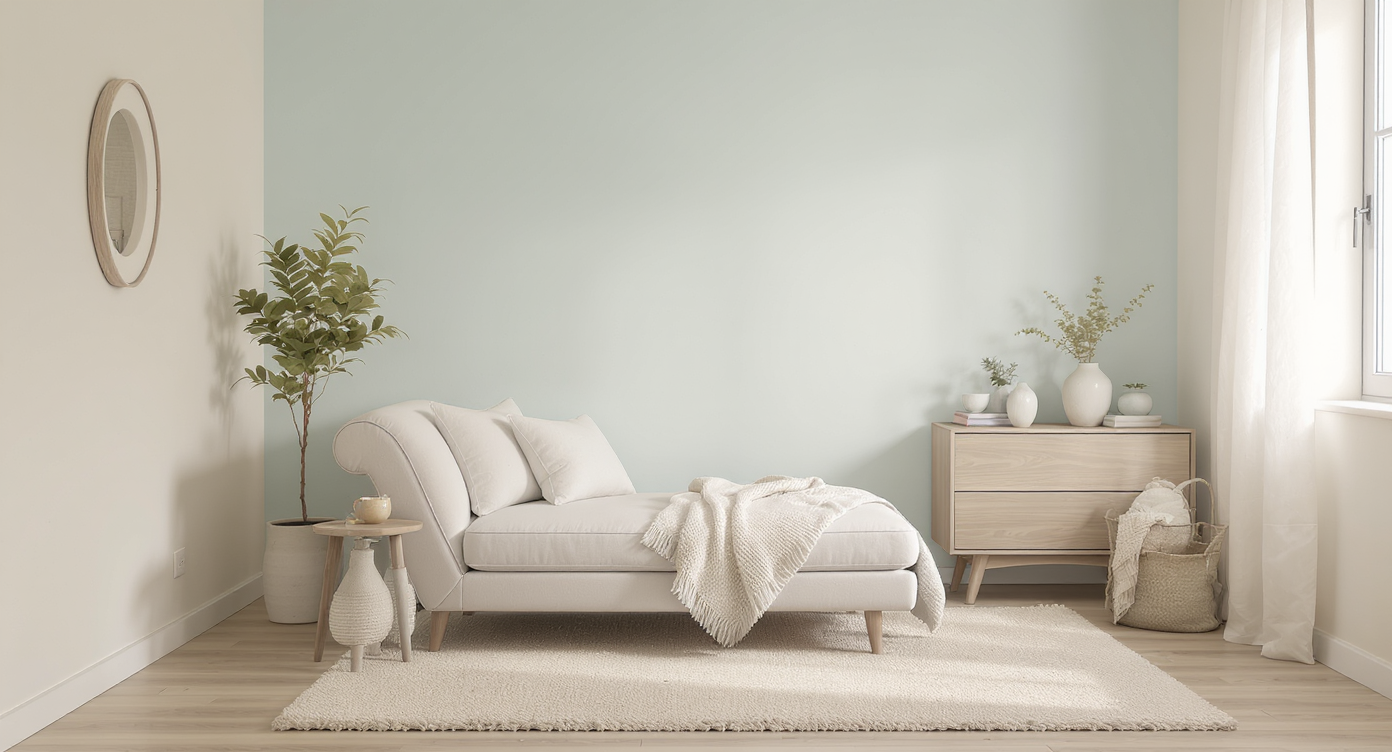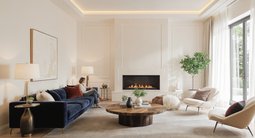TL;DR
Calm is the defining bedroom interior design style for 2025, led by Japandi’s warm minimalism, quiet color, and tactile layers. If you want a no-stress zone, simplify the palette, soften the light, and weave in nature. ReimagineHome.ai lets you visualize a room makeover from one photo, compare styles, and test paint-and-furniture combos in seconds so decisions feel easy, not overwhelming.
Why Japandi Bedroom Design Matters Right Now

Soft minimalism and natural materials make Japandi design perfect for calm bedrooms.
Japandi design trends matter because calm bedrooms directly support better rest and recovery, and this interior design style delivers serenity without sterility. Blending Scandinavian simplicity with Japanese warmth, Japandi is a modern decor framework that tames clutter, softens light, and emphasizes natural materials for instant home design inspiration. At a glance - Simplify the color story: 2–3 complementary hues plus warm neutrals for a soothing, no-stress zone - Try the ceiling: a pale blue-green overhead reads sky-like and calming while walls stay neutral - Layer tactile textures: linen, boucle, washed cotton, and matte wood add depth without visual noise - Create a small seating nook: one chaise or a chair + ottoman shifts unwinding away from the bed - Add joy, not clutter: one statement (a sculptural light or textured wallpaper) can carry the mood - Ground with rugs: layer an area rug to define the sleep zone and add softness underfoot - Bring the outside in: a trio of easy plants and clear surfaces boosts serenity Early CTA: See Japandi in your own bedroom in minutes with ReimagineHome.ai — upload a photo and explore styles now: https://www.reimaginehome.ai/?utm_source=blog
What’s Driving This Design Trend (1/3 of life is spent sleeping)

One-third of life is spent sleeping—design your bedroom for ultimate calm and comfort.
One-third of your life is spent sleeping, which is why bedroom-focused design trends are prioritizing recovery, gentle light, and visual quiet. The rise of Japandi is a response to two needs people repeat most: less clutter and easier choices. Culturally, we’re swapping constant stimulation for slower rituals: reading lamps over overhead glare, textured throws over busy prints, plants over objets. Functionally, this interior design style reduces decision fatigue by using restrained palettes and honest materials. Think white oak instead of high-gloss veneer; nubby linen instead of slick satin; rounded corners instead of sharp silhouettes. Even small moves shift stress levels: replacing a bright 4000K bulb with a warm 2700–3000K lamp relaxes the room instantly. For color, muted blue-green ceilings are trending because they mimic open sky while walls remain a calm warm gray, white, or clay. If you love deeper color, keep it tonal: cerulean with moss, clay with cocoa, in low-sheen finishes that diffuse light. Minimal visual contrasts make the eye “meander,” which reads as calm. Ready to test palettes without repainting? Use ReimagineHome.ai to try trending interior design styles 2025, from Japandi to Soft Minimalist, directly on your space: https://www.reimaginehome.ai/?utm_source=blog
Anecdote
On a rainy Sunday, a couple uploaded a quick phone photo to ReimagineHome.ai. Ten minutes later, they were debating two versions of the same room: one with a misty blue ceiling and a boucle bench, the other with a clay accent and a wood-framed headboard. The decision felt easy because both looked like their actual bedroom—just calmer.
How This Style Looks in Real Homes (60-30-10 color balance keeps palettes calm)

Applying the 60-30-10 rule helps maintain calm, balanced Japandi bedroom palettes.
The 60-30-10 rule keeps palette control: 60% main neutral, 30% secondary tone, 10% accent for a modern decor balance that stays restful. In a Japandi bedroom, 60% might be warm white walls and drapery; 30% pale wood and oatmeal textiles; 10% a sea-glass blue or soft olive. Textures do the heavy lifting. Designers often layer 3–5 textures per vignette: a washed-cotton duvet, linen shams, one faux-fur or boucle throw, and a ribbed ceramic lamp on a matte oak nightstand. The result feels plush without visual busyness. Lighting matters, too: diffuse light through linen shades or frosted glass; use dimmers; place a small, low-glare lamp near a reading chair to create a winding-down ritual. Layout-wise, keep 30–36 inches between the bed and larger pieces for easy circulation. If space allows, a single chaise or an upholstered chair and ottoman by a window creates an “unwind zone” that isn’t your pillow. On floors, layer a rug over carpet to define the sleep area; just keep pile heights similar and secure edges with double-sided tape for safety. Small joy, big impact: one sculptural chandelier, or a subtly metallic, textured wallpaper behind the headboard, brings personality without visual clutter. Finish with three plants (vary the heights) in simple planters—snake plant, pothos, or ZZ—so the greenery remains the focal point. Want to see these combos on your actual floor plan? Try ReimagineHome.ai’s photo-to-style restyle to visualize a room makeover from one photo.
Modern Tools That Help You Explore This Style (AI style variations generate in under 10 seconds)

AI tools like ReimagineHome.ai generate Japandi style variations in seconds for quick design inspiration.
AI design tools can produce style variations in under 10 seconds, making exploration faster than traditional mood boards. Here’s how today’s options stack up for home design inspiration: - Classic mood boards: Great for gathering ideas, but they don’t show your room’s light, angles, or scale. - Floor plan and 3D walkthrough tools: Useful for layout, yet they require measurements and time to build. - Style recommendation engines: Fun for direction, yet they rarely visualize your existing architecture. - AI restyle from one photo: This is the shortcut most people want—upload a snapshot and see your own bedroom in different interior design styles. Why ReimagineHome.ai wins for realism and speed: - One photo, no measurements required: Step straight into Japandi, Scandinavian, Minimalist, or Farmhouse Modern looks on your actual space. - Large furniture and decor vocabulary: Suggests paint color and furniture combinations that feel believable. - Accurate lighting and materials: Shadows, reflections, and textures read real, which helps you judge what to buy. - Iteration without rabbit holes: Tweak palette temperature, swap rug patterns, and compare 3–5 variations side-by-side. Explore more on the blog: - How to get AI style recommendations that fit your space: https://www.reimaginehome.ai/blogs/ai-style-recommendations - Scandi vs. Japandi — key differences you can visualize: https://www.reimaginehome.ai/blogs/scandi-vs-japandi - Turn one photo into a complete bedroom room makeover: https://www.reimaginehome.ai/blogs/one-photo-room-makeover
Step-by-Step — Try This Style Using ReimagineHome.ai (3 simple steps from one photo)

Try Japandi style in your own room with three easy steps using ReimagineHome.ai.
Three steps and one photo are all you need to try this interior design style right now. Step 1 — Upload a photo: Stand in the doorway, capture the whole bed wall if possible, and include floor and ceiling for context. Step 2 — Choose your style and palette: Select Japandi or Soft Minimalist, then set warm neutrals with a blue-green or clay accent. Toggle “declutter” if you want a cleaner baseline. Step 3 — Iterate like a pro: Generate 3–5 variations. Compare a pale blue-green ceiling versus white; swap a boucle throw for a linen quilt; test a larger rug. Save your favorites and use them as a shopping and paint plan. Try it now: https://www.reimaginehome.ai/?utm_source=blog
Visualization Scenario
Upload a wide shot of your bedroom. Select Japandi. Choose warm neutrals + blue-green accent. Generate five variations: neutral ceiling vs. sky tone, linen vs. boucle textures, pale oak vs. darker walnut nightstands. Save the one that feels like you exhale when you see it.
FAQ
Q: How do I choose an interior design style for a small bedroom? A: Start with function (storage, circulation), then pick 2–3 words that describe the mood you want—calm, warm, grounded. Use ReimagineHome.ai to compare Japandi vs. Scandinavian vs. Minimalist on your actual photo. Q: What paint colors work best for a serene bedroom? A: Warm whites, soft grays, and muted nature tones (blue-green, clay, olive) in matte or eggshell. Keep a 60-30-10 palette ratio and test lighting at 2700–3000K. Q: Can I visualize a room makeover from one photo? A: Yes. ReimagineHome.ai is designed for single-photo restyles with realistic materials and lighting, so you can preview modern decor before you buy. Q: Which AI design tools feel most accurate for bedrooms? A: Look for the most accurate AI interior design apps that handle shadows, reflections, and texture. ReimagineHome.ai prioritizes realism and offers paint-and-furniture combo suggestions. Q: What’s a budget-friendly first step toward Japandi? A: Declutter surfaces, swap to warm bulbs, add one textured throw, and bring in a medium-size rug that anchors the bed. Layer in plants last for a calm finish.
Visualize Your Style’s Next Chapter (60 seconds to see multiple looks)
Sixty seconds is often enough to preview multiple looks, which means you can move from indecision to action the same evening. Imagine the glow of a 2700K bedside lamp, the quiet hush of a boucle throw, the soft horizon of a blue-green ceiling—all placed with confidence because you saw it first. When design trends meet better sleep, everyone wins. Use ReimagineHome.ai to explore trending interior design styles 2025, test paint-and-furniture combos, and land on the most intentional, no-stress version of your bedroom. Upload one photo, choose your interior design style, and press go: https://www.reimaginehome.ai/?utm_source=blog
.svg)

.svg)














.png)